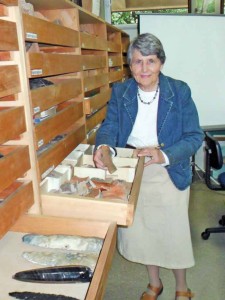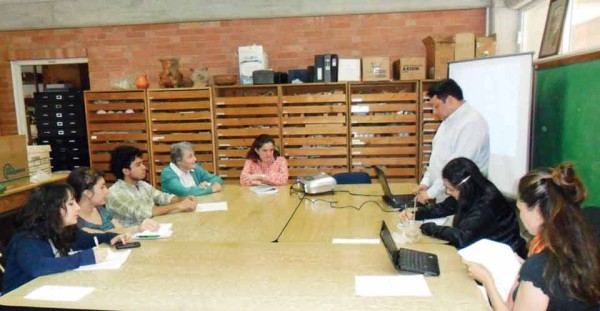Studying Archaeology in Guatemala
The search is on for student funding at the Universidad del Valle de Guatemala
by Tomas Cernikovsky
Famous for its breathtaking Mayan ruins, Guatemala has “great archaeological potential” for future studies, scholars say, but university tuition is beyond the reach of many potential archaeology students, especially those from indigenous families.That’s why leaders of the Archaeology Department at the Universidad del Valle de Guatemala (UVG) are appealing for donations to help students from families with limited resources to study archaeology. Currently such students cannot afford to start the program because of the five-5year commitment to obtain the degree of “Licenciatura en Arqueología.”
UVG archaeologist Marion Popenoe Hatch, who received her Ph.D. from the University of California, Berkeley, set up the UVG Archaeology Department in 1982 and has worked since the 1970s researching the Tak’alik Ab’aj site. In October 2012, archaeologists announced the discovery of the oldest Mayan royal tomb yet found in Mesoamerica, 2,500 years old, claiming that this makes Tak’alik Ab’aj the “cradle of Mayan culture.”
Dr. Hatch spends a week each month at the site. She analyzed and dated the items found in the royal tomb, confirmed by a radio carbon dating test by a Miami, FL lab.
In addition to Tak’alik Ab’aj, Dr. Hatch and UVG colleagues are actively excavating, with Tulane University, the “Site Q,” also called La Corona. They are working on a new site at Semetabaj, above Lake Atitlán, which will become a tourist destination, and digitizing the valuable archive of the late Tikal field director Edwin Shook, for use in modern explorations.
Dr. Hatch, along with Archaeology Department Director Tomás Barrientos, one of the graduates of the UVG program, said funding is urgently needed to open doors to more students.
“The program is the only one in Guatemala that provides multi-lingual scientific training in archaeology, which is essential, because the majority of bibliographic references are published in English. The UVG archaeology course promotes critical thinking and a broad based coursework preparation,” she explained.
“The course prepares its graduates for work as investigator, museum curator and expert in Mesoamerican archeology. It teaches the theory of archaeology, the techniques of exploration and excavation of sites, classification and analysis of ceramics and burial grounds discovered and how to use the evidence to explain the past. In general, graduates of the UVG course are currently directing active archaeological projects and work in museums, carrying out research and publishing to advance the archaeological knowledge in Guatemala.”
Barrientos further explained that Archaeology Department enrollment is relatively small, on average 20 students with five to six new students every year.
“Being a small department, it allows us to offer a personal education that also maximizes all educational resources that we have. Our students come from all parts of the country and even from other countries of Central America.”
Recognizing that many worthy causes seek public support, Barrientos said that donating to scholarships for archaeology studies at UVG will generate numerous long-term benefits for the economy and society overall.
“The main reason (to donate) is because Guatemala is a country with a great archaeological potential,” he explained. “Archaeology is one of the many underdeveloped activities that will contribute to the future improvement of the country, in terms of opening new economic activities such as tourism. Supporting the education in archaeology will produce better professionals that need to tell the true history of Guatemala, bringing pride to our past as the basis for the future.
“Nevertheless, many young people, especially Maya, who want to study archaeology at UVG have to give up because of economic limitations. Despite the availability of different financial aids at UVG, there is much need of a direct support coming from donations, whether through individuals or institutions,” Barrientos said.
To contribute any amount, however large or small, please visit www.cernikovsky.com/UVG.htm for more details, plus the complete interview with Tomas Barrientos and more photos. Visit the same page for more about the recent discovery at Tak’alik Ab’aj of the oldest Mayan royal tomb in Mesoamerica. For more information about Universidad del Valle de Guatemala visit uvg.edu.gt


Buenos tardes! I just returned from your beautiful country and can’t wait to return! One of the objectives of my trip was to visit some Maya monuments and gather information for my Cultural Resources Management course I’m taking here at Colorado State University. I was thankful to visit Tikal but definitely did not have enough time to gather the information I desired. I’m hoping you can help me or guide me to whomever may. My question is, are there any government regulations pertaining to how to conduct archaeological projects? Are permits granted to people/organizations if they desire to excavate an area which may potentially have historical monuments or objects? Who issues the permits?
Finally, if a government project (i.e., road expansion or constructing a building) is being proposed, does your institute have the authority to evaluate the land before the project begins? Please point me to any other information you feel may be of benefit for me to learn how you protect your amazing historical places.
Con mucho gusto!
Lori